Dear reader: This article contains links to products and services that I may be compensated for, at no extra cost to you.
Taroko Gorge, named after the Truku or Taroko aboriginal tribe, is arguably Taiwan’s top scenic attractions. Few people visit without being blown away by its sheer magnificence and raw natural beauty. It is the star attraction of Hualien, Taiwan’s largest county (see my Hualien guide and other places to visit in Hualien), on the wild and visually stunning east coast.
Taroko Gorge can be reached in a mere 2-3 hours from the capital, Taipei, yet it feels world’s apart.
I wrote this guide to Taroko Gorge based on many visits I’ve made over the last 15 years. In it, I’m going to cover all the main things to do in Taroko Gorge, how to get there, where to stay, how to do Taroko Gorge as a day trip from Taipei, and why I think Island Life Taiwan offers the best Taroko Gorge tours.
For more general information about traveling in Taiwan, also be sure to see my introduction to Taiwan travel.
2024 Update: On April 3, 2024, a massive earthquake struck the Hualien region. Taroko Gorge is heavily damaged and all of Taroko National Park (including Taroko Gorge and Hehuanshan) is totally closed to visitors. It is expected that the gorge will be closed for a full year.
Trains are now running again from Taipei to Hualien and onward to Taitung. Damage in Hualien city is less serious, but some hotels have closed for repairs.
See my newest guide: things to do in Hualien which are still currently open.
Table of Contents
Welcome to Taroko Gorge
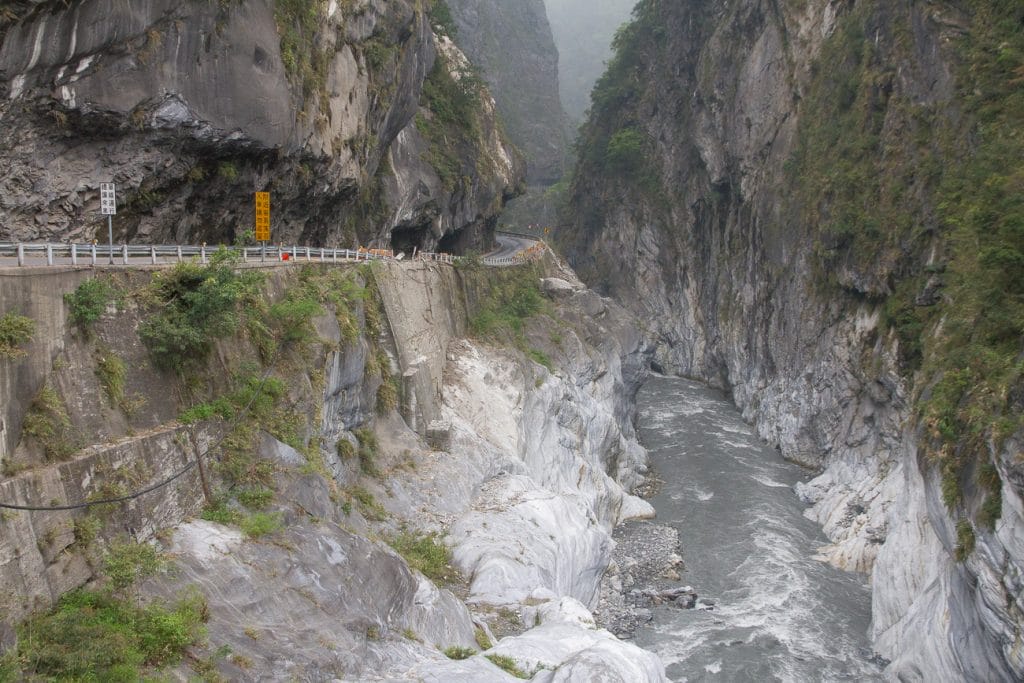
Taroko Gorge is the country’s premier scenic attraction, along with Alishan and Sun Moon Lake. It is featured on my list of best places to visit in Taiwan and it is an essential stop on any Taiwan itinerary.
The area referred to as Taroko Gorge is a steep, dramatic valley created by the Liwu River (立霧溪), which flows from Taiwan’s Central Mountain Range east to the Pacific Ocean. The blue-green waters of the Liwu River have carved out immense, vertical cliffs of marble and gneiss.
The Japanese first made the area a national park, called Tsugitaka-Taroko National Park, during their colonial rule of Taiwan from 1895 to 1945. This was the first national park ever in Taiwan. After the Japanese left, the KMT government later abolished the national park, and it wasn’t reestablished again as Taroko National Park until 1986 (later than others, such as Kenting National Park).
Many people don’t realize this, but Taroko National Park is much larger than just the famous tourist section called Taroko Gorge. In fact, the park extends all the way up to the Central Mountain range, including the famous mountain Hehuanshan, one of the best places in Taiwan to see snow.

Super-narrow Provincial Highway 8 runs up Taroko Gorge. The highway was first built in the late 1950s, and the 212 veterans who died while building it are today commemorated at Eternal Spring Shrine.
Highway 8 is actually the start of the Central Cross-Island Highway as it follows the Liwu River upstream and then continues over the high mountains all the way to Taichung City on the west coast. The first 19 kilometers or so of the highway are what we typically consider Taroko Gorge.
In the Central Mountain Range, Highway 8 also connects to Highway 14, which continues to famous attractions like Hehuanshan, Wuling Pass (Taiwan’s highest), Cingjing Farm, and Puli (access point for Sun Moon Lake).
2024 Taroko Gorge Closures
Taiwan’s high mountain roads are subject to frequent closures due to damage from typhoons and landslides. Several storms in 2022 and 2023 have caused multiple road closures on Highway 8, including one right in Taroko Gorge.
As of early 2024, there are five areas of construction on Highway 8, and two of these are inside Taroko Gorge.
For several months in 2023 and early 2024, one spot was only open to let cars pass five times per day. Because of this, bus 310 from Hualien city to Taroko Gorge and bus 302 from Xincheng to Taroko Gorge were reduced to only a few per day.
In March 2024, this was updated to 8 opening times per day (10 minutes every hour on the hour from 9 AM to 4 PM, then open all night from 5 PM to 8 AM and open on weekends and holidays). Bus 310 and 302 are back to normal schedule.
New updates about these road closures are released on the first day of every month on the Taroko NP park website (click small arrow beside Highway 8). However, this information can be difficult to understand. For interpretations of their information, including maps I made, please join my Taiwan Travel Planning group and see my most recent posts about Taroko Gorge.
These closures will also slow down anyone planning to drive from Taroko Gorge to Hehuanshan (or vice versa). The drive is still doable, but I suggest starting your day as early as possible because there are likely to be delays.
How Many Days for Visiting Taroko?
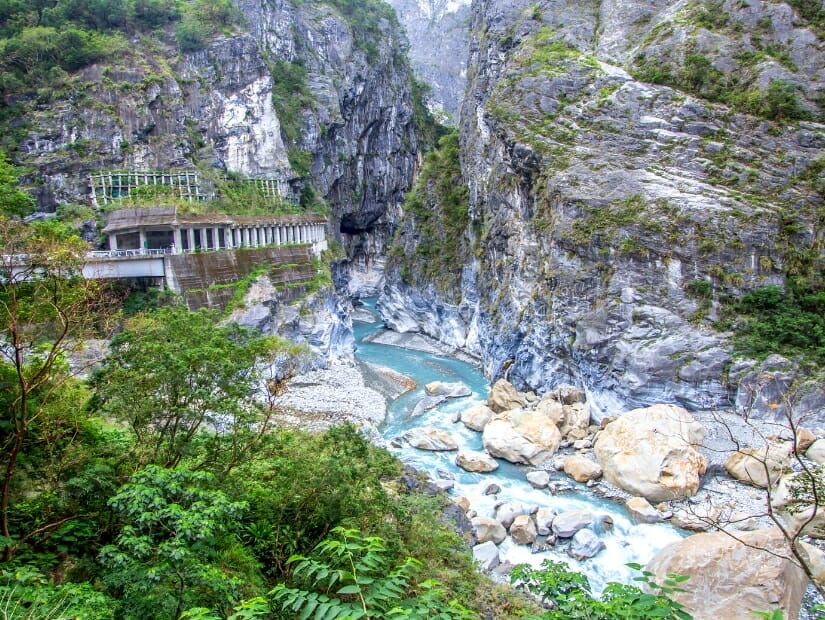
Most people spend one entire day visiting Taroko Gorge, whether they self drive, take a day tour, or hire a private driver for the day.
One option is to arrive in Hualien very early, do your day tour, spend the night, then continue to your next destination the next day. However, if you’re coming by train, note that even the first train of the day won’t get you there early enough to catch most tours.
Another option is to arrive and check in to your hotel on Day 1, do your Taroko day tour on Day 2, then head on to your next destination in the evening. To make your visit more relaxed, spend two nights or more there, so you don’t have to do any traveling on the same day as your Taroko tour.
With a full day, you’ll be able to visit most of the places I describe in this article, including at least one or two short hikes. You’ll also most likely be able to visit Qingshui Cliffs and Qixingtan Beach, two attractions outside of the gorge that are included on most Taroko day tours. I’ll further introduce both of these places below.
Taroko can even be done as a day trip from Taipei, but it makes for a very long day. You can book this day trip with transportation from Taipei, but it makes for a very long day, with 8-10 hours of driving. A better option is to go to Xincheng on your own by train and hire a driver from there.
If you have even more time in the area, you’ll want to check out more things to do in Hualien here, my recommended Hualien itinerary, my two guides to the east coast of Taiwan, covering Yilan to Hualien and Hualien to Taitung and Kenting National Park, as well what to do in Taitung, the county below Hualien.
If you visit Taroko Gorge during a long weekend or especially the latter half of the Lunar New Year holiday in Taiwan, be prepared for some serious crowds! You can see more information on the best times to visit Taroko Gorge in my guide to when to visit Taiwan.
Also note that, like most of Taiwan, Taroko Gorge are very safe for solo or female travelers, as this female traveler reports in her Hualien guide.
Best Taroko Gorge Tours
The most convenient way to see Taroko Gorge, especially if you want to cover the main sights in one day, is by taking a tour from Hualien city. There are several cheaper options available on Klook, but I personally recommend Island Life Taiwan Tours.
The reason I recommend them is because they specifically design their tours to avoid the crowds everywhere they go, including starting a little earlier than other tours. Also, their groups are small and their tours are conducted in English. They are also highly reviewed and have a five star rating on Tripadvisor.
To cover the main sights described in this article, choose the Better Taroko Gorge Tour. The tour also includes some off-the-beaten-track spots that other tours don’t, such as the Changuang Bell Tower Trail, the Baiyang Waterfall Trail, and the Water Curtain Cave, which you will read about below. They even provide flashlights and raincoats for entering the Water Curtain Cave. Because the tour starts at 7:30 AM, you’ll need to sleep in Hualien City or Xincheng the night before.
They also offer fully customized tours and can arrange permits and guide you through the thrilling Zhuilu Old Trail (which I’ll introduce below).
Getting to Hualien
Hualien city is the capital of Hualien county and the main access point for Taroko Gorge.
Most people take the regular (TRA) train to Hualien city, but there’s also the option to fly from Taipei’s Songshan Airport. Going from Taipei to Hualien by bus is not easy, fast, or practical. Driving is slower than taking the train, but the drive is quite scenic.
If you’re starting your trip in Taipei, be sure to check out my Taipei 4-day itinerary, list of 50 things to do in Taipei, and guide to the best hotels in Taipei.
Flying from Taipei to Hualien
This flight from Taipei Songshan Airport to Hualien only takes 50 minutes. This is quite convenient because Songshan Airport is right in the Taipei City center and you can even get there by MRT.
However, this option is not necessarily faster than taking the train. If you factor in the time needed to get to Songshan Airport, check in for your flight, then get from Hualien airport to Hualien city center, flying would actually take a little longer than the fastest train to Hualien.
The fastest express train to Hualien can get you from Taipei Main Station to Hualien Station in a mere 2 hours 6 minutes (the last time I checked), or 2 hours 1 minute to Xincheng Station (the station closest to Taroko Gorge).
However, these express trains often sell out, and there are only a few per day. So if that happens, and you don’t want to take a slower train, you might consider flying.
Train from Taipei to Hualien

Taking the train is by far the most common and preferred method for getting from Taipei to Hualien. However, demand for these trains is very high, especially the express ones (called Puyuma Express or Taroko Express), and they often sell out, especially on weekends, long weekends, and holidays.
Therefore, it’s crucial to book your train in advance (up to 28 days) on the official TRA website. Note that these trains are not High Speed Rails (the HSR only goes down the west coast of Taiwan). After you book and pay online, you can pick up your physical ticket from a convenience store iBon machine or at the ticket window at the station in Taiwan.
There are two train stops that are relevant for getting from Taipei to Taroko Gorge. Tiny Xincheng (Taroko Gorge) station is much closer to the gorge, but has few facilities and accommodations. The next stop, Hualien station in Hualien City, the county capital, is further away from Taroko Gorge, but has way more hotels, hostels, restaurants, night markets, and so on.
The fastest trains from Taipei to Hualien take just over 2 hours (TWD 440). For these trains, you must have a reserved seat. No standing tickets are sold. So once the seats sell out, it is not possible to ride these trains. These trains are called Puyuma, Taroko, or Tze Chiang 3000.
Slower trains take anywhere from 2 hours 15 min to 3 hours 30 min(TWD 340). They are called Chu-Kuang, Tze Chiang (all numbers except 3000), or Fast Local. For these trains, booking a seat is still recommended. But even if the train sells out, you can still buy a standing ticket. Then you’ll need to stand in the aisle or sit on the floor in the space between train cars (it’s not comfortable, but I’ve done it many times).
For more information, see my guide to taking trains in Taiwan.
Driving to Hualien

For total freedom, you can rent a car from various locations in Taipei or across Taiwan. However, driving from Taipei to Hualien is actually quite a bit slower than taking the train, even the slower trains.
The main reason you might consider doing this is because it is a beautiful drive from Taipei to Hualien, especially the coastal section from Su’ao to Hualien. You could easily make a full day of it, passing places like Jiaoxi Hot Springs, Su’ao Cold Springs, Nanfangao Seafood Harbor, and (just before reaching Taroko Gorge) the beautiful Qingshui Cliffs.
Another plus is that once you get to Hualien, you don’t have to figure out how to get to Taroko Gorge, because you can just drive through the gorge by yourself.
If you do drive, take care on the coastal highway, as it is narrow in parts, with steep cliffs down the sea. Once in a while (though not commonly), landslides destroy this highway and he can take a few days to reopen again, as happened most recently in early 2023.
See my guide to road tripping from Yilan to Hualien for more details.
Getting to Taroko Gorge on Your Own
Once you arrive in Hualien city, it’s a 30 to 40-minute drive back to Taroko Gorge, and most Taroko day tours start with pick-up in Hualien city.
Some people get off the train in Xincheng, a small town that is closer to Taroko Gorge (5-10 minutes), but has fewer services. If you have arranged a private driver, it makes sense to have them pick you up at Xincheng.
Private Driver
Getting a private driver is not a bad or expensive way to explore Taroko Gorge, especially if you have a few people to share the cost. Most drivers have a proposed itinerary for Taroko Gorge, but you can also make your own customized schedule. The drivers will even wait for your if you want to do one of the hikes in Taroko Gorge.
Most taxis drivers in Hualien can do this, or you can book a private driver online.
By Scooter
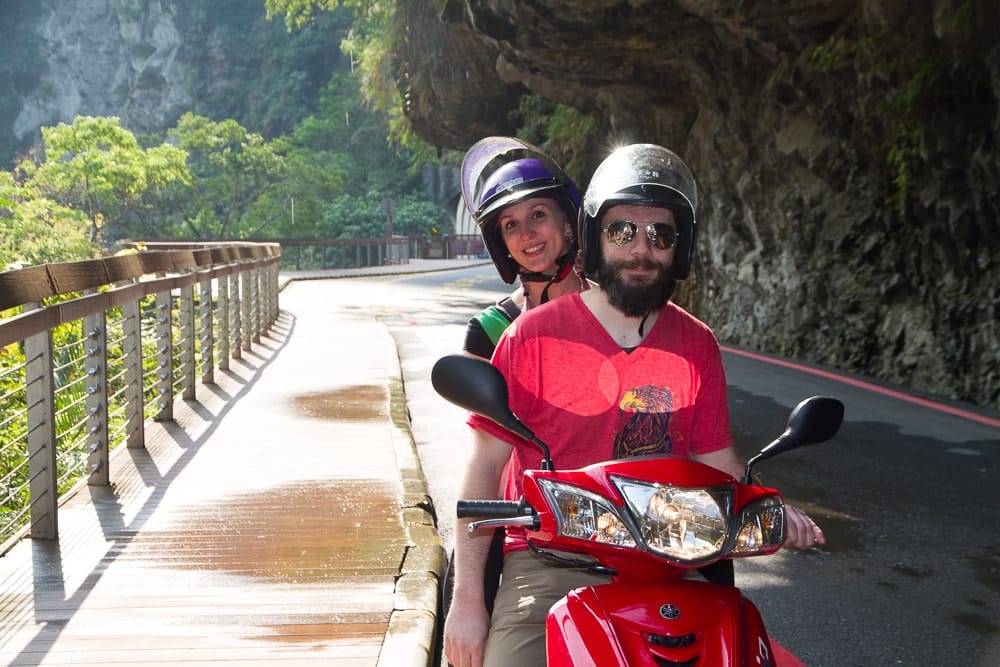
If you want to get to Taroko Gorge by scooter, there are scooter rental stations outside of Xincheng and Hualien train stations. Helmet and rain jacket are provided, and you’ll need a local Taiwanese scooter license or IDP (international driver’s license). Your home country’s license won’t be good enough.
Riding a scooter in Taroko Gorge gives you the freedom and flexibility to stop wherever you go. Riding through the tunnels and between the valley walls of Taroko Gorge is an incredible experience. However, it must be noted that there have been multiple scooter accidents in Taroko Gorge in recent years, some tragic, so you should do so at your own risk.
Having said that, we have even visited Taroko Gorge by scooter with our kids.

Taking the Bus to Taroko Gorge
Visiting Taroko Gorge by bus is the slowest and most inconvenient, but cheapest way. The buses are infrequent, so you really need to time it well. Still, the bus isn’t a bad option, and with some planning and an early start, you can still see a few of the main highlights of Taroko Gorge in a day.
Hualien county runs regular buses (NT170 per person, no change given, four per day) and tourist shuttles (NT 250 day pass, 13 per day) from Hualien through Taroko Gorge to Tianxiang, the village at the head of the Gorge, stopping at Xincheng station on the way. The whole drive takes about 1.5 hours one way (but you’ll likely get off sooner). Here are the schedules for route 310 from Hualien and route 302 from Xincheng.
Here’s the most recent Taroko Gorge bus route and schedule. When you land on the page, it might revert to Chinese. So you need to switch the language to English, click on Hualien on the map, then click on “Taroko Route”.
Cycling to Taroko Gorge
Cycling Taroko Gorge is the most adventurous way to take in the dramatic scenery that Taroko Gorge has to offer. You might want to avoid weekends and holidays, when traffic is much heavier.
Be warned that some of the roads in Taroko Gorge are very narrow and don’t provide much space between you and passing tour buses. Also, don’t go cycling in Taroko Gorge during or after heavy rain or a typhoon during summer in Taiwan. In 2017, a Japanese cyclist died from a landslide in Taroko Gorge for this reason.
You can rent bicycles around Hualien and Xincheng stations for about NT250 per day, but I’d suggest not wasting your time riding all the way from Hualien station to the entrance of Taroko. A smart thing to do is to rent a Giant bicycle near Hualien station, take your bike on the local train to Xincheng, the ride on from there.
From Xincheng station, it only takes 15 minutes to cycle to the entrance of Taroko, or you can take the bus to the entrance and rent a bike there.
Cycling into Taroko Gorge, the road is going to be uphill the whole way, but it’s not super steep. If you’re a beginner biker, you may find it tough, but for experienced cyclists, it should be a breeze.
Where to Stay in Taroko Gorge
Choosing where to stay when you visit Taroko Gorge can be a tough decision. Three main options are staying right in Taroko Gorge, staying in Xincheng (the small town near the entrance to Taroko), or staying in Hualien city.
Hotels in Taroko Gorge are limited and pricey. Xinxheng is very convenient and close to Taroko, especially because it has its own train station (Xincheng station, which is one stop before Hualien City). Hualien City is the furthest, but it has the best choice of budget accomodations and many things to do.
Hotels inside Taroko Gorge
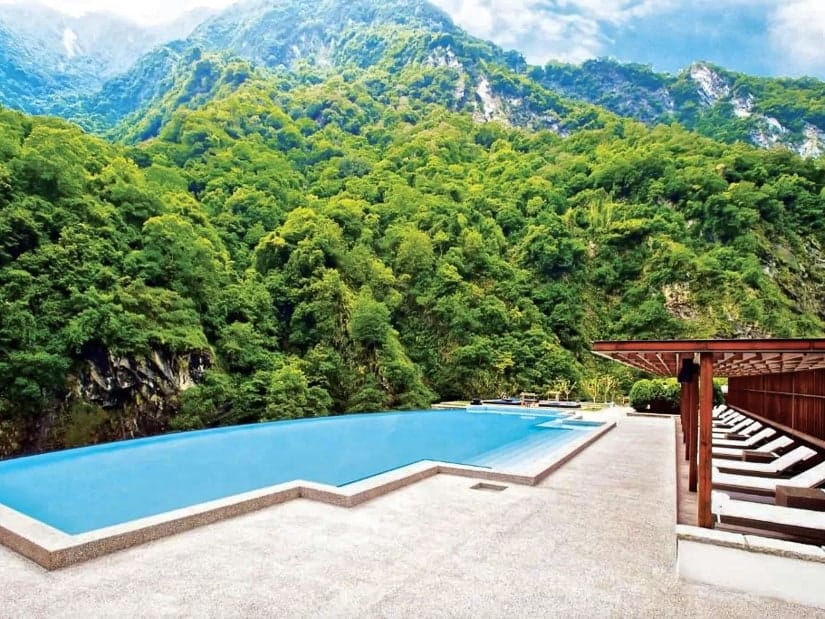
For the full Taroko experience, you can stay right inside the gorge. Driving there is best, but the hotels can also arrange pickup from Xincheng or Hualien.
Silks Place Resort (see on Booking / Agoda / Klook / TripAdvisor) at Tianxiang, the small village at the top of Taroko Gorge, is the only 5-star hotel in Taroko Gorge National Park. It’s got a fancy swimming pool and incredible views. See my other recommended 5-star hotels in Taiwan.
Taroko Village Hotel (see on Booking / Agoda / Klook / TripAdvisor) offers wooden huts and aboriginal buffet dinners. We stopped here for a lavish feast when we camped at Heliu campground to enjoy the best of both worlds! (If you want to learn how to cook aboriginal cuisine, check out this cooking course in Hualien!)
If you want to spend a night at the head of Taroko Gorge without breaking the bank, try the Tienhsiang Youth Activity Center (see on Agoda / TripAdvisor). You’ll need to get there on your own. From the hostel, you can walk to a few (but not all) of Taroko’s attractions.
Hotels in Xincheng
If you want to stay very close to Taroko Gorge, but also have train access, then staying in Xincheng is best. Get off the train at Xincheng (Taroko Gorge) station.
Taroko Liiko Hotel (see on Booking / Agoda / Klook / TripAdvisor) is an excellent choice very close to the train station. Most rooms come with beautiful views.
Liwu Hotel (see on Booking / Agoda / Klook / TripAdvisor) is the closest you can get to Taroko Gorge without actually being inside the national park. It’s a 6-minute drive (or 45-minute walk) from Xincheng Station.
From a very quiet stay in a beautiful local house, try Crossing the Rainbow B&B (see on Booking / Agoda / Klook / TripAdvisor). This is a simple local guesthouse. It is slightly closer to Xincheng but further from Taroko. It’s a 30-minute walk out of town in the direction of Qingshui Cliffs.
For an off-the-beaten track experience, try Songyue Guesthouse (see on Booking). It is located in Sanzhan, a small aboriginal village 10 minutes’ drive from Xincheng. Sanzhan is a great spot for swimming and jumping into the river (see the end of the article for pictures).
Hotels in Hualien City
Hualien City offers by far the largest range of accommodation options, but it is furthest away from Taroko Gorge. Staying in Hualien allows you to enjoy the city’s restaurants and night markets at night. Taroko Gorge is a 30-40 minute drive away.
If going by public transportation, choosing something near Hualien train station is smart.
Two of the best hostels in Hualien are Just Walk Backpacker Hostel (see on Booking / Agoda / Klook / TripAdvisor) and View Hostel (see on Booking / Agoda / TripAdvisor).
For a good mid-range option, Happiness is My Home (see on Booking) lives up to its name – the owners of this guesthouse are super welcoming and helpful. Another excellent choice near Hualien night market is 1999 B&B (see on Booking / Agoda).
Hualien Farglory Hotel (see on Booking / Agoda / Klook / TripAdvisor) is the best resort option. It features both ocean and mountain views and swimming pool, in a quiet, remote location south of Hualien City.
Camping in Taroko Gorge
16.5km up the valley, Heliu Campground offers 12 wooden platforms for first-come-first-serve camping at NT200 per space. There is also overflow camping at nearby Lushui Campground. There’s are very basic campgrounds with limited amenities, so you need to bring everything you need, including food and water. There’s a self-pay system at Heliu, while the even more basic Lushui is free.
I stayed here with my family several years ago, and while the facilities are lacking, it was an awesome setting. If you need to pick one up before your trip, this guide covers some recommended tents. The campgrounds are close to a few attractions and a hike, which I will cover below.
Things to Do in Taroko Gorge
Taiwan is a geologically active island, and in few places is this more apparent than at Taroko Gorge. Earthquakes, typhoons, and landslides regularly destroy roads and trails in the gorge, continually reshaping its landscape. For this reason, you must keep in mind that one or more of the attractions or trails in Taroko Gorge might be closed when you go.
Every time I’ve ever been to Taroko Gorge, at least one or more of the main sights or trails has been closed. One time when I visited many years ago, the entire highway was closed for set times every day past the Swallow’s Grove, which meant I couldn’t make it to several spots.
You can avoid disappointment by checking what’s open and closed before you go on the Taroko Gorge National Park website. Click “News” then “Roads and Trails”. Under Road Conditions Highway 8, you can find out if any sections of highway are closed. Then, Level 0 to 5 refers to the various hikes in Taroko Gorge by difficulty.
Having said all that, here are the main things to see and do in Taroko Gorge, in the order you would encounter them going in. More places to visit near Taroko Gorge will be covered in the next section below.
Taroko Gorge Entrance Gate
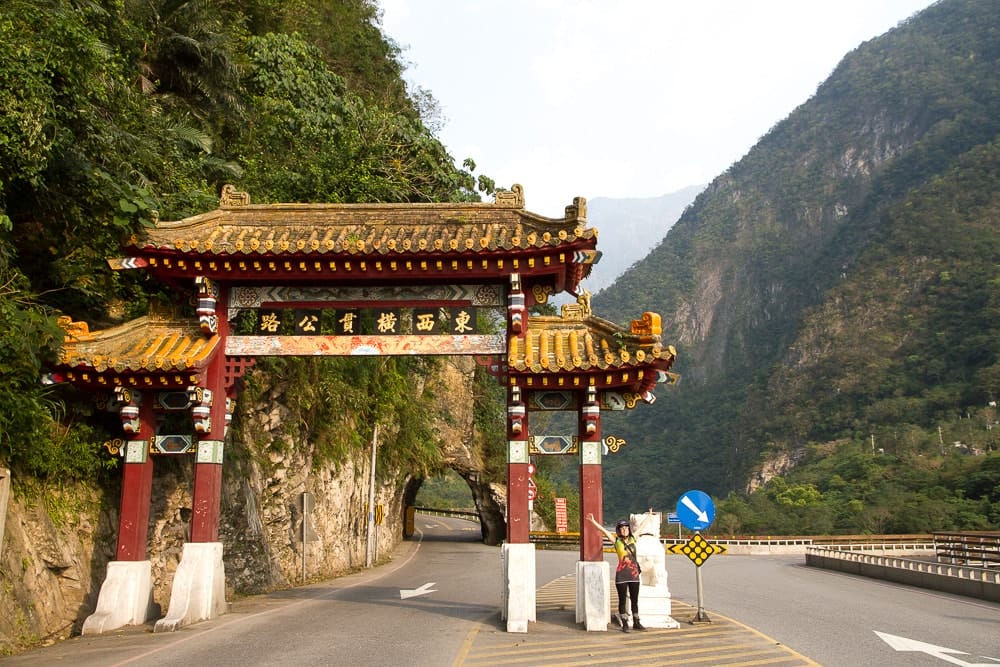
Welcome to Taroko Gorge! Tacky as it may seem, we can never resist stopping here for a photo, and you will probably want to do the same 🙂
The entrance gate (called 東西橫貫公路牌樓 on GoogleMaps) officially marks the entrance to Taroko Gorge. Just past the gate, turn right and cross the bridge over the river to reach Shakandang Trail (see below) or the Taroko National Park Visitor’s Center. You can see the bridge on the right side of the above photo.
For all other sights in Taroko Gorge, keep to the left, passing through the iconic rock arch visible in the photo above.
If you stay at one of the hotels I mentioned in Xincheng, like Liwu Hotel, you would be only five minutes’ walk from here.
Shakadang Trail
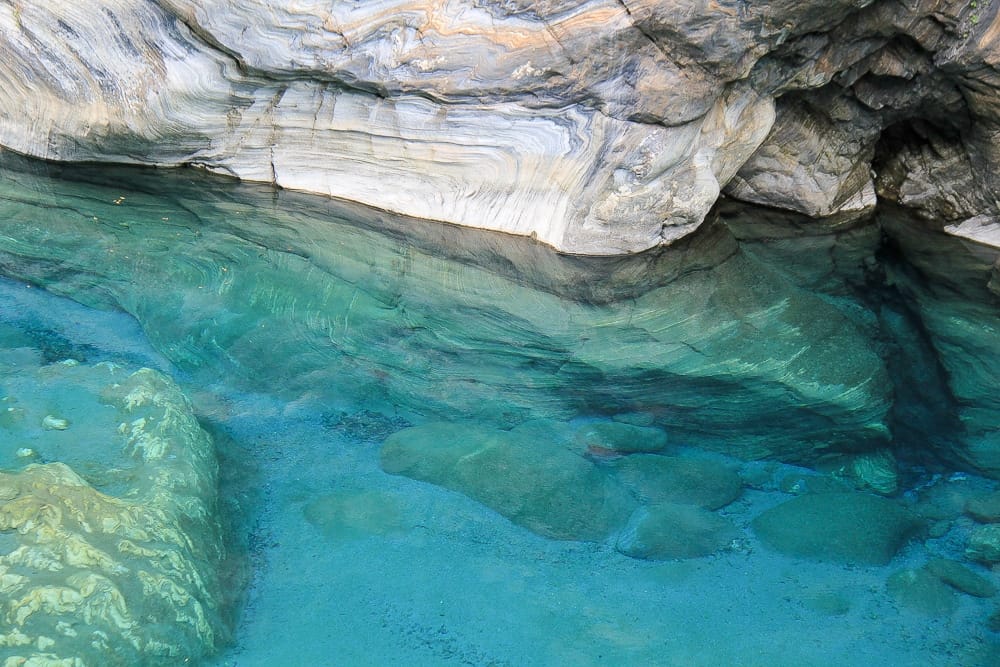
Shakadang Trail (砂卡噹步道), or “Mystery Valley Trail”, is an easy trail that follows a creek with crystal clear, sapphire pools of water. You WILL want to jump in, but you aren’t technically allowed to swim or go off the trail since people have died here.
This easy 4km walk takes about 2 hours return if you go the whole way (when the whole trail is open – check the national park site for current opening situation). This trail is a great one for visitors with kids, as it is mostly flat and you only need to walk as far as you want then turn back.
The trail passes through a Truku aboriginal village, where locals sometimes sell crafts or snacks along the trail.

To get there, cross the bridge that goes over the river at the Taroko Gorge Entrance Gate. Just turn right after the entrance gate from the previous entry. Turn left after crossing the bridge, and drive about five minutes past the Taroko National Park information center.
Buses also stop at the start of Shakadang Trail. If you come here with a private driver, they will be willing to park and wait for you while you do the hike. Note that the trail is sometimes closed for maintenance, so it’s best to find out before you come.
If you’ve walked into Taroko Gorge, you can walk from the Visitor’s Center to the start of Shakadang Trail on a trail along the river (also called Shakadang Trail on GoogleMaps), which is nicer than walking along the road.
Eternal Spring Shrine
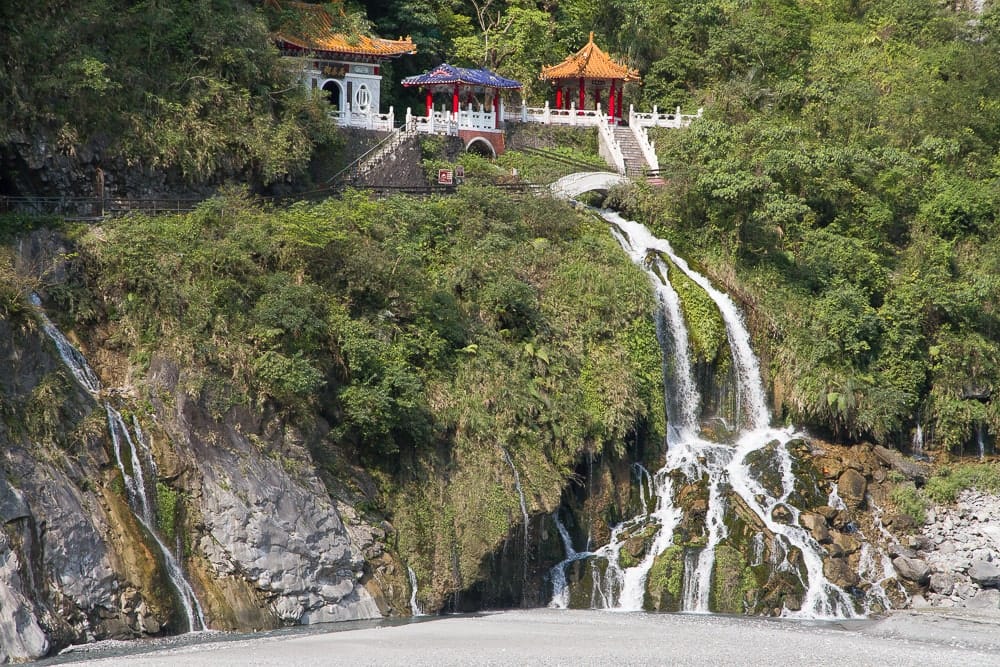
The Eternal Spring Shrine (長春祠) is probably the most recognizable sight in Taroko Gorge and often crowded with tour groups. A picturesque waterfall streams out from the mountain, with a large colorful shrine built up around it to honor the many who died when the highway was first carved out by the Japanese in the 1910s.
From the large parking lot, the walking trail to the shrine goes through a tunnel that contains some smaller shrines. However, these tunnels and access to the shrine are sometimes closed due to damage by landslides.
When accessible, you can walk right up to the stream that runs through the shrine before it spills down to the valley floor below. If that part is closed, you can simply admire the shrine from the viewpoint next to the large parking lot.
Changuang Temple
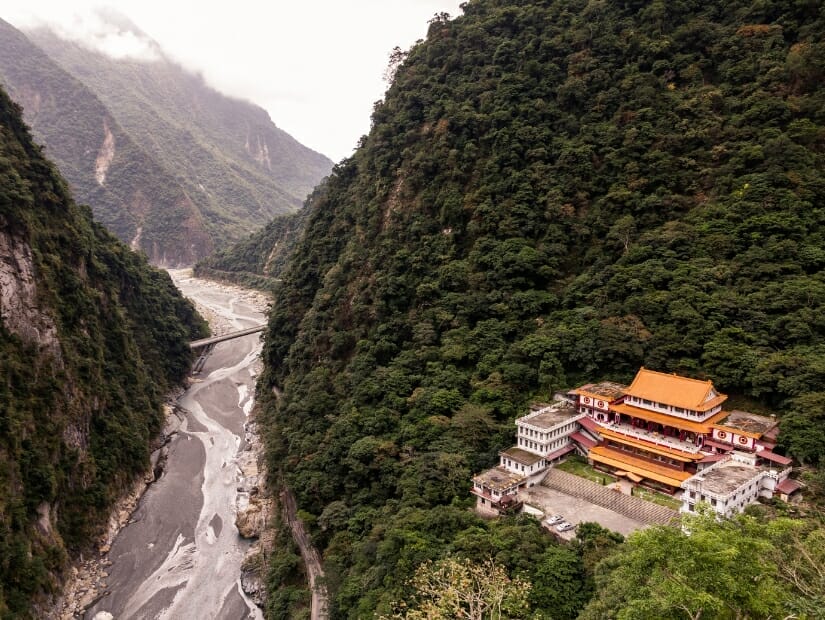
A lesser known stop right next to the famous Eternal Spring Shrine is Chuanguang Temple (禪光寺). Although it looks very large in the above photo (shot by a drone), you won’t actually notice it when you drive through Taroko Gorge or visit Eternal Spring Shrine. That’s because it is uphill from the main road and hidden by the trees.
The easiest way to get to Changuang Temple is by walking up the car road to it. Going this way, it only takes about 15 minutes to walk from Eternal Spring Shrine to Changuang Temple. It is also possible to take a longer but more scenic hiking route there via Eternal Spring Bell Tower (see below), but the trail is partially closed as of 2024 (see link in next entry for latest info).
Eternal Spring Bell Tower
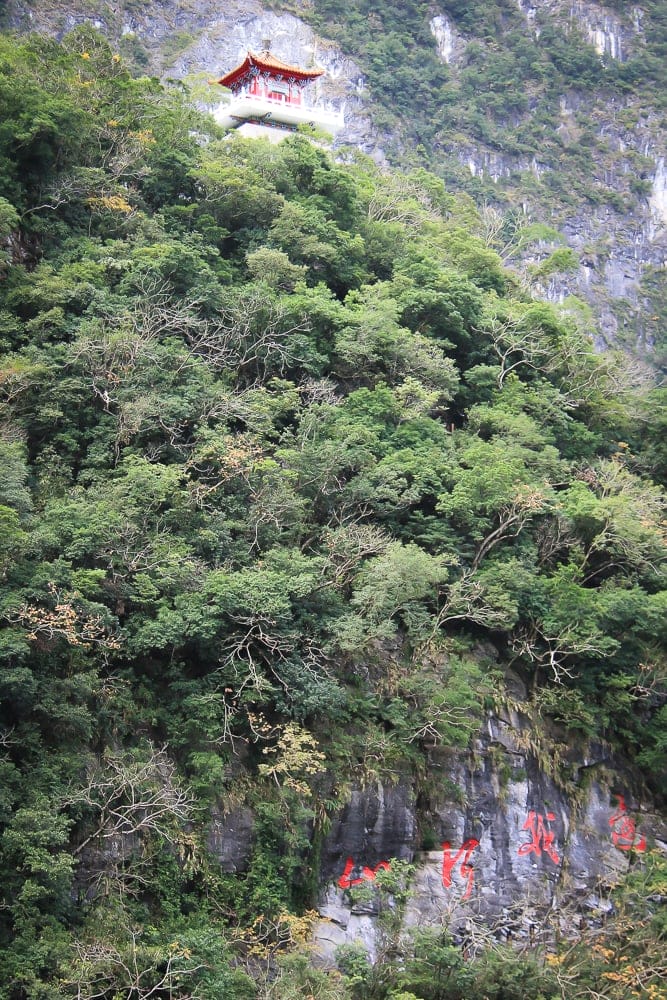
Although you can’t actually see Changuang Temple from below, you can see the beautiful Eternal Spring Bell Tower (長春鐘樓), also sometimes called Changuang Bell Tower (禪光鐘樓) from the Eternal Spring Shrine area, as in the above photo. On GoogleMaps, the bell town might look very close to the main highway, but it’s actually far, far above the highway on top of a cliff.
The Bell Tower is on a hiking trail called Eternal Shrine Trail (Changchun Shrine Trail) that starts at Eternal Spring Shrine and ends at Changchun Temple, so you can normally get to the Bell Tower from either. However, both ends of the trail appear to be closed due to landslide damage as of early 2024.
If you walk to the Bell Tower from Changuang Temple, the steep trail takes approximately 20 minute. This trail crosses a suspension bridge before getting there. If you start from Eternal Spring Shrine, the trail is longer (approximate 1 hour) but more scenic. The trail passes Guanyin Cave (觀音洞), which seems to be currently closed, and Taroko Tower before reaching the Bell Tower.
This guide to Eternal Spring (Changchun) Bell Tower Trail on the official Taroko website has a map of the trail and information about current closed sections (although the information is a little confusing). If you manage to reach the Bell Tower from either side, please let me know in the comments!

For temples lovers, be sure to check out my guide to the top 30 temples in northern Taiwan.
Buluowan
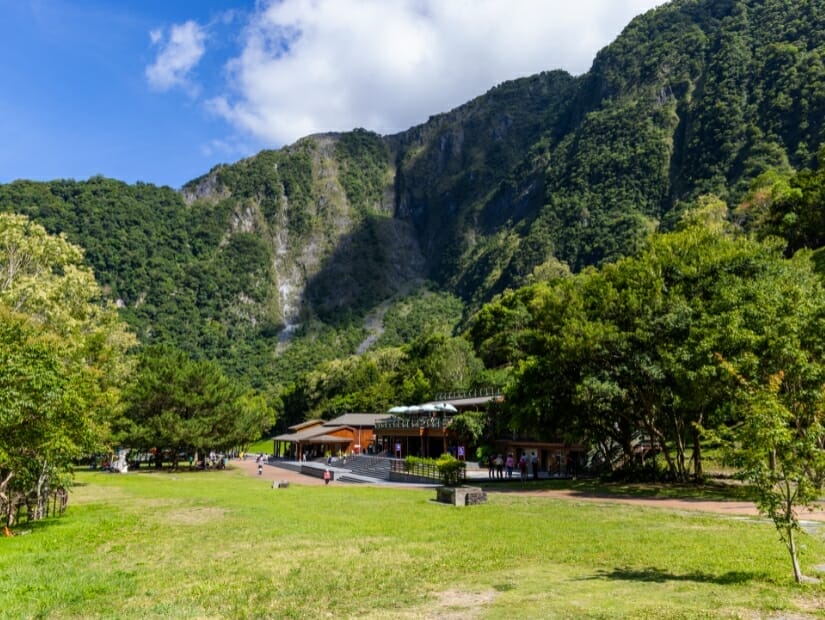
Buluowan is a grassy terrace sitting above the highway. It used to be the site of a real Truku (Taroko) aboriginal village. Today, the Buluowan Service Station (布洛灣遊憩區) has some small exhibits on Truku culture and handicrafts, sculptures, and simple lunchboxes and other snacks.
From the service center, you can follow a walking trail to Buluowan Terrace and Buluowan Suspension Bridge (布洛灣吊橋). At 152 meters above the Liwu River and 196 meters in length, it is the tallest and longest suspension bridge in Taroko National Park. The trail there is flat and easy to walk.
Taiwan tourist shuttle 310 (when running) makes a stop at Buluowan Service Center as it drives through Taroko Gorge.

Taroko Village Hotel sits on another plateau a little higher up from the service center. This is the only place where you can stay in cabins with aboriginal design in Taroko Gorge.
During one of our trips to Taroko Gorge, we visited here to enjoy an aboriginal buffet meal for dinner, which was excellent.
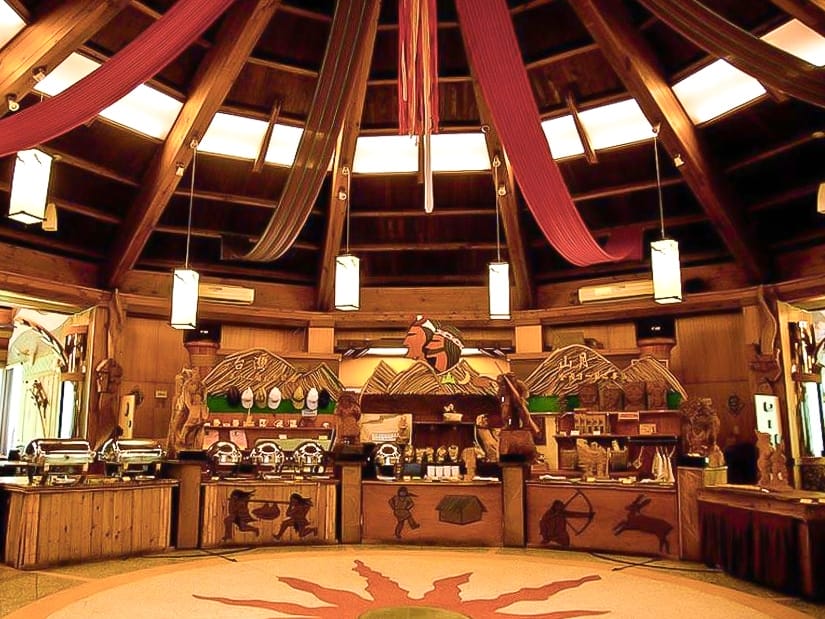
Swallow Grotto

Swallow Grotto/Swallow’s Grove (燕子口 or Yanzikou) is a stretch of road that veers off from the main highway and through multiple tunnels. You can park at the side then walk along the road, peering over sheer vertical drops to the river far below—classic Taroko Gorge scenery.
The vantage points and short walking trail here get their name from the swallows who build nests in the cliff face. You can also cross Zhuilu Suspension Bridge nearby, which is the start of the Zhuilu Old Trail (see next entry).
You’ll want to take caution here, as most of the walking path shares the road with vehicles, including a series of dark tunnels. If driving though, do so very slowly and watch for pedestrians.
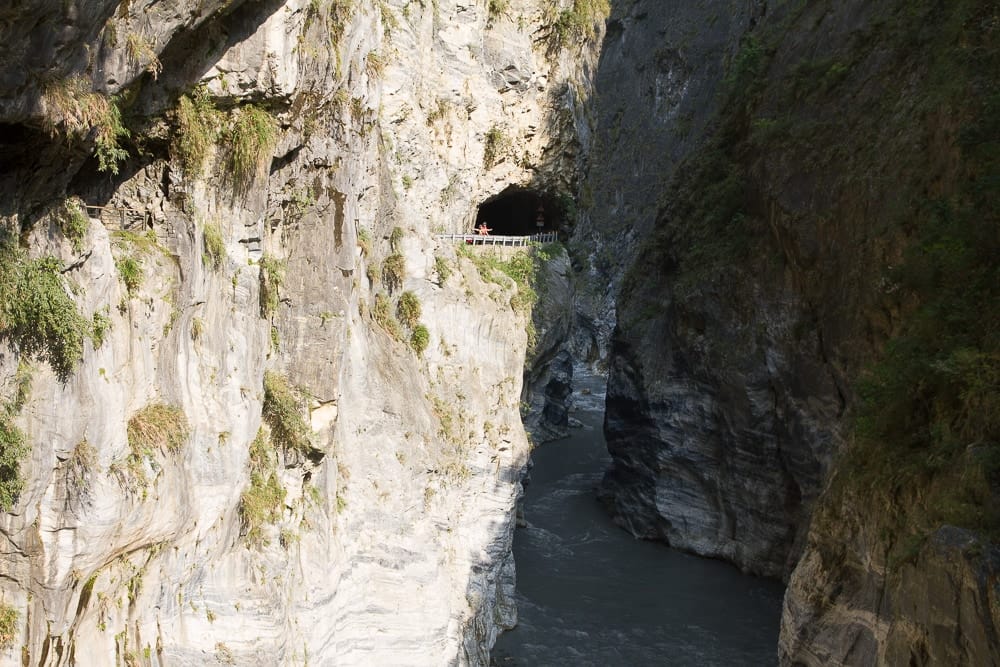
The road that goes through these tunnels continues for one kilometer (one way direction for vehicles) before joining up again with the main highway. Because the road is prone to landslides, don’t be surprised if it is closed when you visit.
There’s a cliff that looks like a Native American chief, small cafe named “The Chief” after it, and a spot where if you look up, the rock cliffs make a Taiwan shape in the sky.
Taroko National Park headquarters suggest wearing helmets when visiting Swallow’s Grotto, which are available for free at the visitor’s center and at the spot marked “Free Helmet Rental” (太魯閣峽谷安全帽發放處) on GoogleMaps, on the main road about 1 km before Swallow Grotto.
Zhuilu Old Trail
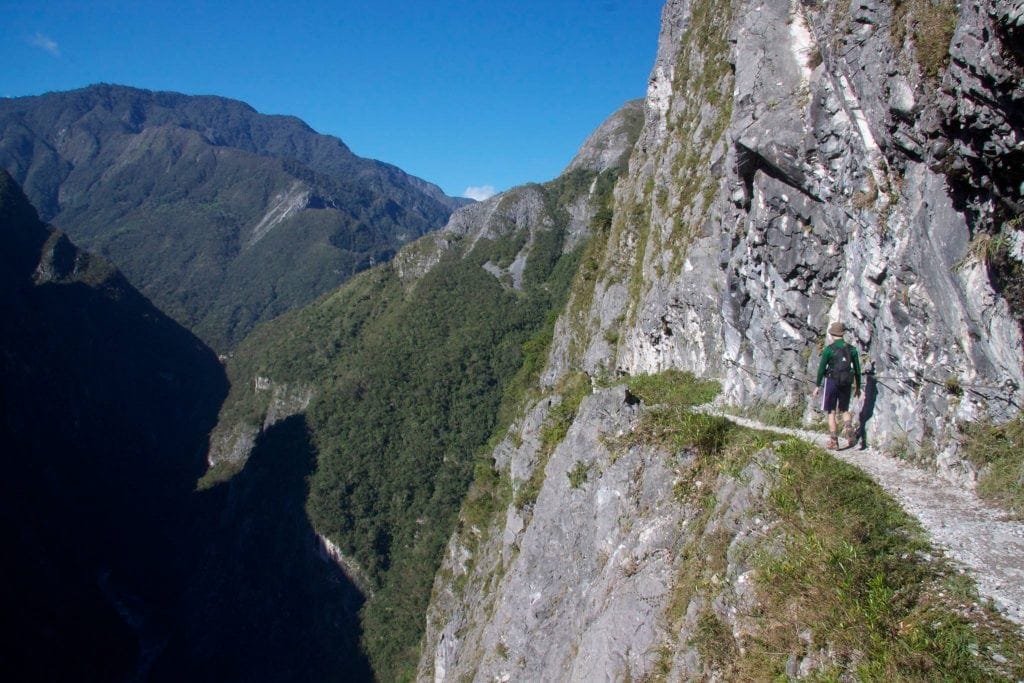
Taroko Park’s most exhilarating hike, Zhuilu Old Trail or Zhuilu Old Road (錐麓古道), features narrow trails along sheer 500m+ cliffs and expansive, bird’s eye views over Taroko Gorge. This fairly tough 6-km hike takes 2-6 hours (depending on how much of it is open) and officially requires a permit and guide. Also, you must begin before 10am.
To arrange a guide and permit, simply book the tour online with Island Life Taiwan Tours and they will arrange it for you. This hike is still on my Taiwan bucket list, so I’ve used a friend’s photo above.
At the time of writing, only the first 3.1km were open, so definitely check the status on the national park website or with the tour company before you go. Sometimes, even though it says “open”, only a small part of the trail is open.
The trail starts by crossing Zhuilu Suspension Bridge (錐麓吊橋) across the Liwu River just before Swallow Grotto. If you don’t have a permit, you can still cross this bridge, but you can’t go any further up the trail.
Liufang Bridge Observation Deck

Stop at this small parking lot and observation deck, called Liufang Observation Deck (流芳橋觀景台), for a unique and impressive view.
Climb the wooden stairs up to the observation deck and you can look down on the highway as it emerges from two tunnels through the mountain, one for traffic in each direction, and then crosses Liufang Bridge (流芳橋).
Unfortunately, there is no bus stop here.
Tunnel of Nine Turns
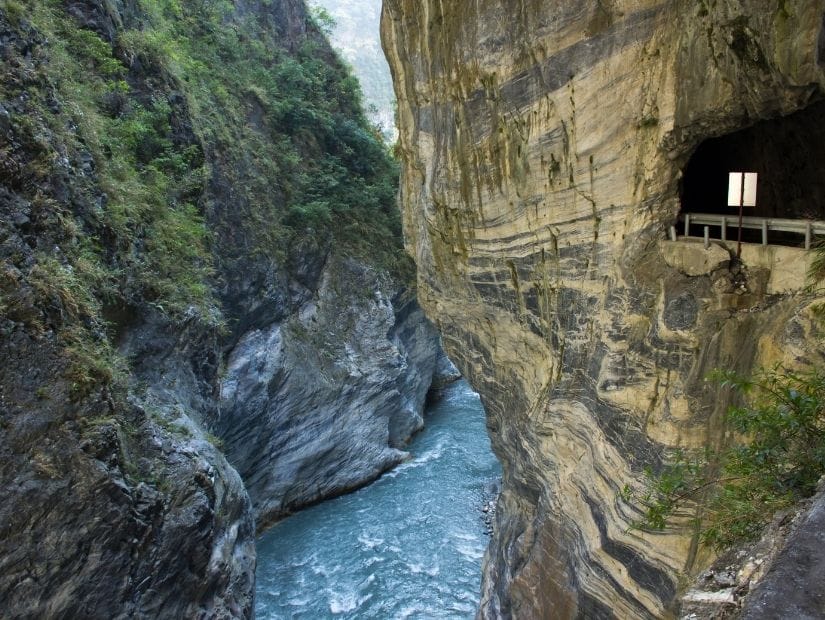
The Tunnel of Nine Turns (九曲洞隧道 or Jiuqudong) is a dramatic stretch of walking-only tunnels that was closed for six years due to major damage from a landslide. Fortunately, the tunnel was finally reopened to the public in 2019, after being fully renovated and made safe.
The 700-meter pedestrian-only road features several tunnels and used to be a part of the original highway through Taroko Gorge. It features some of Taroko Gorge’s most epic views and definitely should not be missed. Watch for the beautiful waterfall between the cliffs on the other side.
The trail is about 700 meters and most visitors spend around 30 minutes here. Unfortunately there’s no parking lot here. If you have a driver, the driver will drop you off and pick you up. There’s also a bus stop nearby. If you’re driving and really want to see it, you could park around Lushui and walk there, about 30 minutes each way.
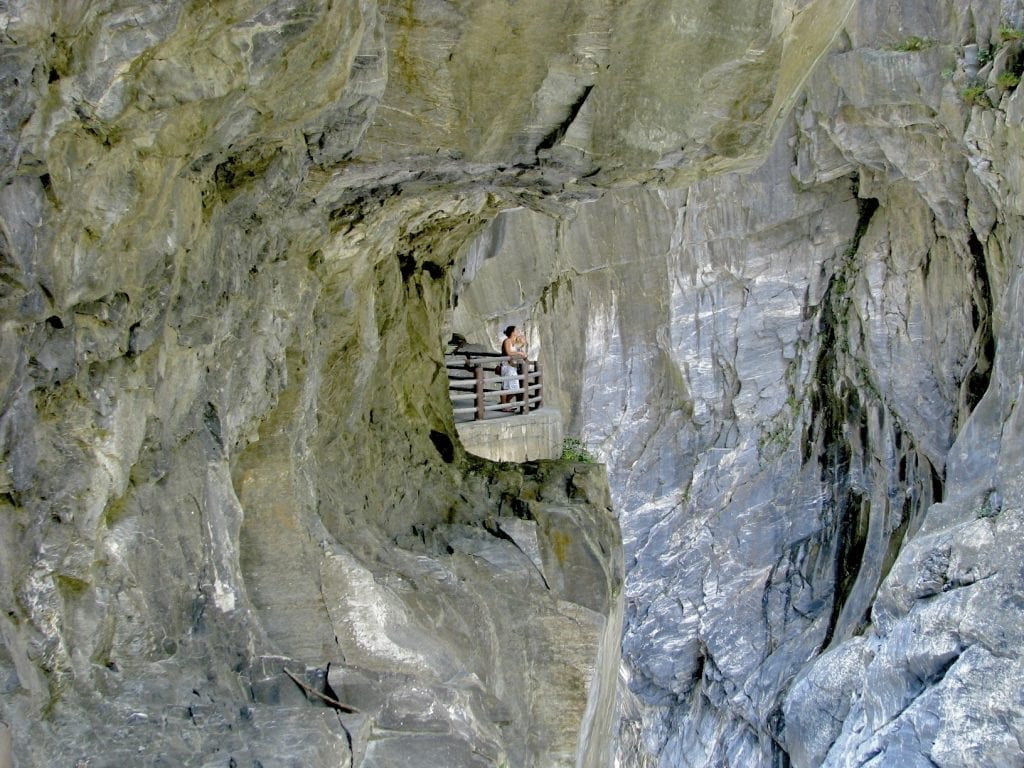
Cimuting, Lanting, Heliuting, and Lushui Trail

There is a small collection of sights around Cimu Bridge (慈母橋). I don’t really consider these essential stops in Taroko Gorge, but if you have more time, or are staying at one of the campgrounds nearby, you may want to visit them.
Cimuting (Cimu Pavilion or 慈母亭) and Lanting (蘭亭) are two small pavilions next to the bridge, but they are a little old and not easy to stop at, as there is very little parking. Further down the road, Yuewangting (岳王亭) is another one, which most people stop at for walking across yet another suspension bridge there.
A little further down the highway, Heliu Campground and the overflow Lushui Campground are the two main campgrounds in Taroko Gorge (see the “where to stay in Taroko Gorge section above”).
Heliu Campground is the start of the Lushui Trail (綠水步道), a pleasant trail that includes sections of forest, a 30-meter cave, a spirit tablet, and river views. It’s an easy trail that takes about an hour.
Tianxiang (Tienhsiang) Recreation Area
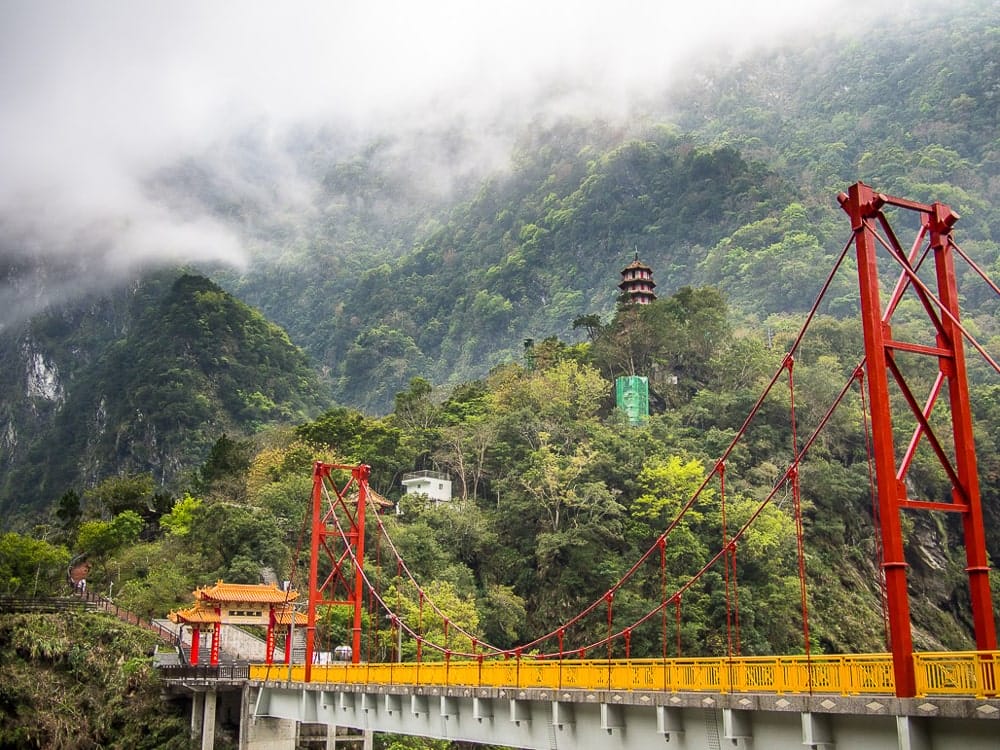
Tienhsiang (Tianxiang) is the only “town” in Taroko Gorge, if we could even call it that. It is the terminal bus stop of buses running up the gorge, beside which you can find a few aboriginal and Taiwanese food stalls and the only 7-Eleven in Taroko Gorge (often low on supplies).
The view from the grassy area marked Tianxiang Recreation Area (天祥遊憩區) on GoogleMaps is good. A short walk from town, can cross Taroko Pudu Bridge (太魯閣菩渡橋, pictured above) and walk up many stairs to the Buddhist Xiangde Temple (祥德寺) and the towering Tianfeng Pagoda (天峯塔, visible at the top of the above photo). There’s a small vegetarian restaurant (素食義賣) on the way up – opening hours may be limited.
Tianxiang is also the location of Silks Place, the fanciest hotel in Taroko Gorge by a long shot, as well as the budget friendly Tienhsiang Youth Activity Center. You can walk to the following trail from this town.
Baiyang Trail and Water Curtain Cave
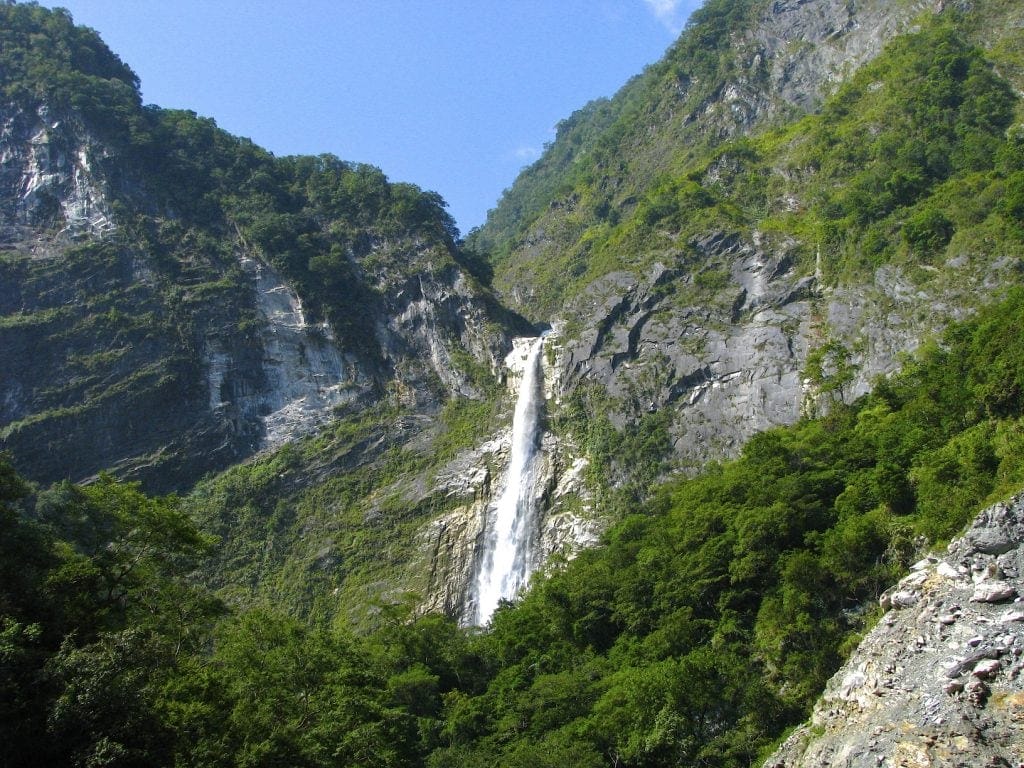
Baiyang Trail (白楊步道) is another easy trail starting 900 meters past Tianxiang, taking you to gorgeous Baiyang Waterfall (白楊瀑布). Past the falls and requiring a little more uphill of a hike is Water Curtain Cave (水濂洞), a tunnel in which water spills down on top of your head as you walk through.
The trail takes less than an hour each way. Parts or all of the trail are sometimes closed for maintenance, so do check on the official site before you go. For most of 2023 and going into 2024, the trail has been open up to Baiyang Waterfall only.
On this tour, you can get flashlights and raincoats for entering Water Curtain Cave, so you don’t get too wet. If you visit on your own and want to walk through the tunnel, it’s a good idea to bring an umbrella or raincoat like we did (see image below).
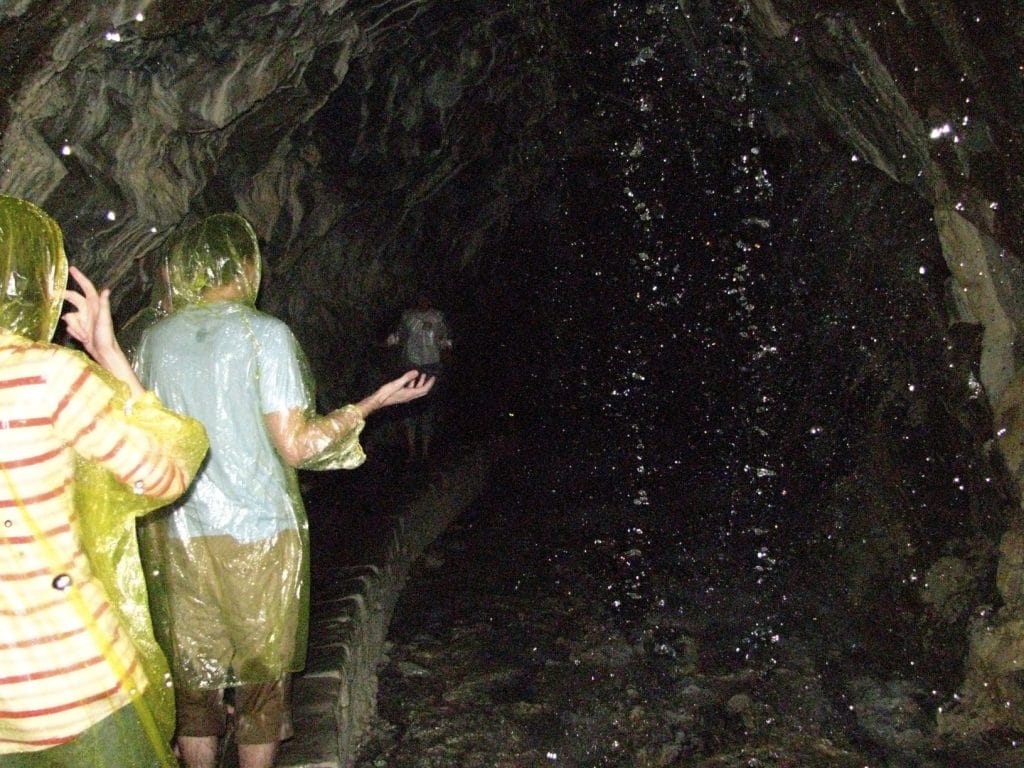
Wenshan Hot Spring
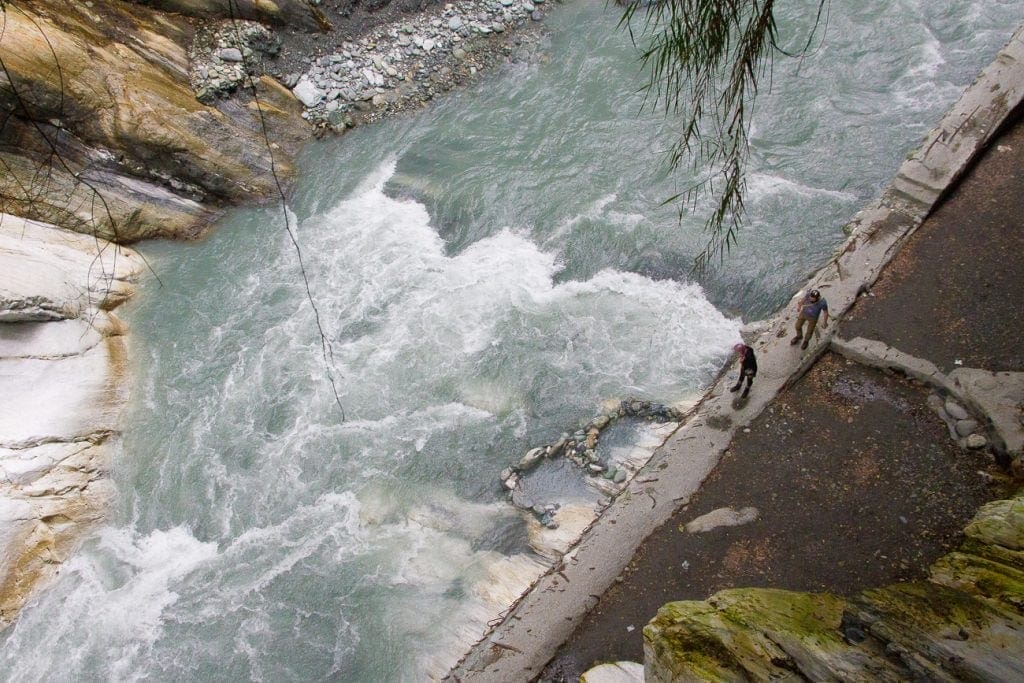
Wenshan Hot Spring (文山溫泉) was once the most famous wild hot springs in Taiwan, being located right inside Taroko Gorge. Destroyed by a typhoon in 2005, it is now technically closed and not recommended to visit by the offiicial Taroko National Park headquarters.
However, by sneaking around a few fences, you can still visit what’s left of it. You can still bathe here, but the conditions are not ideal. To find out exactly how to do so, see my guide to visiting Wenshan Hot Spring.
The hot spring is located 2.5 kilometers past Tianxiang, and is probably the furthest point that you will consider going in Taroko Gorge unless you are planning to on traveling up the long, winding, and often closed road to Hehuanshan (see below).
If you’re looking for a longer hike in Taroko Gorge with virtually no people on it, check out the Lushui Wenshan Trail, which starts around the same point as the trailhead for Wenshan hot spring.
Things to Do around Taroko Gorge
Besides all the sights mentioned above inside Taroko Gorge, there are several other attractions near the gorge that can be combined with your day trip to Taroko Gorge.
You can find more information about these sights, plus many more things to do, in my guide to Hualien and recommended Hualien itinerary.
Qingshui Cliffs
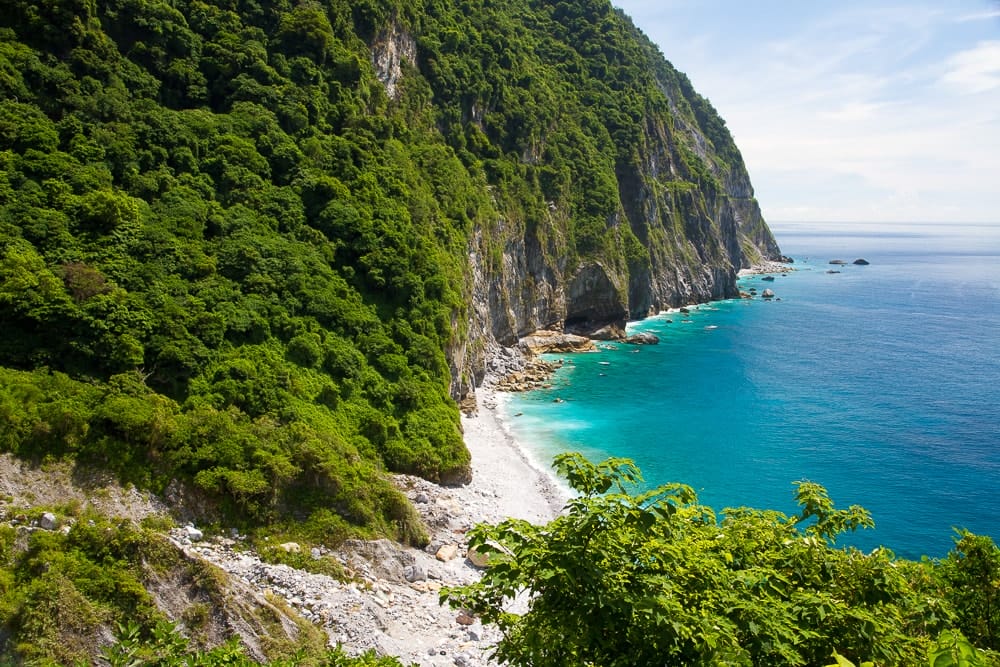
The dramatic Qingshui Cliffs are on the Suhua Highway, which leads from Hualien to Su’ao in Yilan County. The cliffs are located on a stretch of the coast just 10 minutes’ drive north of the entrance to Taroko Gorge, with a few different spots along the coast where you can pull over to see them.
If you’re driving through Taroko Gorge on your own, it would make sense to see them in at the end of your visit. You could also walk to them in about an hour if you’re staying in Xincheng.
Most tours to Taroko Gorge, such as this one, this one, and this one, include a visit to Qingshui Cliffs, but sometimes only if there’s enough time at the end of day.
You can also go whale watching off the coast of Hualien!
Qixingtan Beach
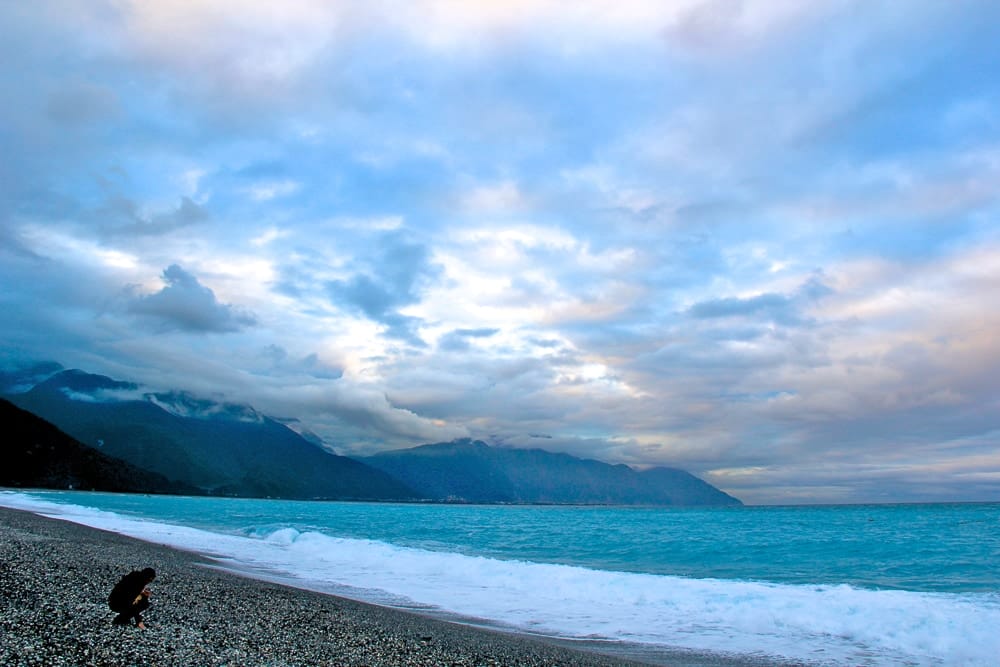
Gorgeous Qixingtan is a beautiful pebble beach between Hualien and Taroko Gorge, so it’s easy to stop there where traveling between the city and the gorge. Most day tours to Taroko Gorge stop at the beach on the way to or from the gorge. You can’t swim there because the tide and waves are very strong, but the views are unbeatable.
There are usually some stalls selling food and drinks at Qixingtan. At busy times you can also rent bikes there to ride along the coast or all the way back to Hualien City, where you can arrange for them to meet you and pick up the bike (some Mandarin skills may be necessary to arrange this).
Qixingtan is included on this tour and this tour.
Hehuanshan and Cingjing Farm
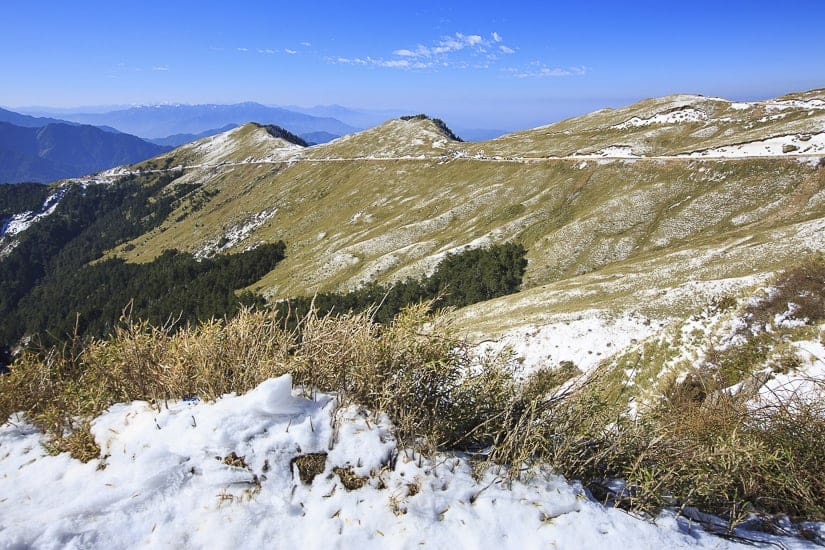
It is even possible to continue further up Provincial Highway 8, the highway that runs through Taroko Gorge, to the Central Mountain Range of Taiwan.
Eventually the highway splits, with Highway 8 continuing across the Central Mountains to Taichung (called the Central Cross Island Highway). Highway 14 goes south and then also traverses Taiwan via Wuling Pass (the highest navigable pass in Taiwan, at 3275 m) and Hehuanshan (Hehuan Mountain). This 3416-meter mountain is considered one of the best places to see snow in Taiwan.
People don’t often realize this, but Hehuanshan is actually in Taroko National Park. Learn all about visiting it in my Hehuanshan guide.
A lot of visitors to Taiwan want to visit Hehuanshan, but it’s not easy to get to. There is no public transportation going from Taroko Gorge to there (there used to be a private shuttle bus from Hualien and Taroko Gorge to Hehuanshan, but it’s no longer running). What’s more, the highway above Taroko Gorge is often closed due to damage by landslides/typhoons (see the section about this at the top of the article).
Therefore, it is much easier and safer to visit Hehuanshan from Taichung on the west side of Taiwan. You can do so by joining this Hehuanshan tour. There’s only one hotel at Hehuanshan and its hard to book – read about it in my guide to staying at Songsyue Lodge.
After Hehuanshan (if you are able to get there from Taroko Gorge), the highway continues on to the popular Cingjing Farm, a gorgeous high-mountain, European-style farm. Again, it is best to get to Cingjing from Taichung, not from Taroko Gorge.
If you keep going, you can continue all the way to Sun Moon Lake and Alishan and then descend to the west coast of Taiwan.
Find all the information about this area in my guide to Cingjing Farm and how to get from Taichung to Cingjing and Hehuanshan.
Sanzhan

The small aboriginal village of Sanzhan (三棧) is only about 10 minute’s drive from Xincheng Train Station and the entrance to Taroko Gorge. The Sanzhan River, which runs past the village, has several great spots for jumping into the water. This is a real treat after a long day of hiking in Taroko Gorge, especially in summer.
To find the jumping spots, search “Sanzhan River Playing Area (三棧溪戲水區)” on GoogleMaps. You can also jump in from the rocks below the bridge just before town, which is where I shot the above photo. There are even more spots around here and a little further up on the Sanzhan River, which is the start of the route to Golden Grotto (see below).
Sanzhan is the starting point for the infamous river trace to Golden Grotto (黃金峽谷), a long, difficult, and at times unsafe river trace that is considered one of the best in Taiwan.
If you want to stay in Sanzhan, perhaps as a very quiet and off-the-beaten-track alternative to Xincheng and Hualien, or because you plan to do river tracing or enjoy jumping in the water, you can spend the night at Songyue Guesthouse. There are a few very basic restaurants in town.

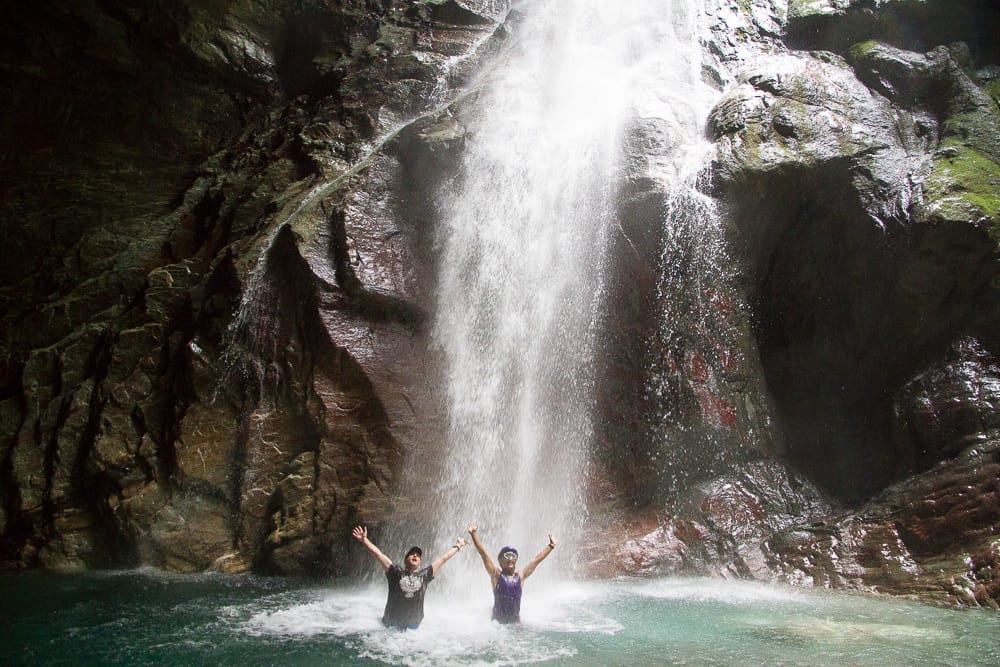

Well, I hope you’ve found all the information you needed for planning your trip to Taroko National Park. Let me know how your trip goes, and be sure to check out my other articles below on the area!

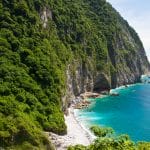
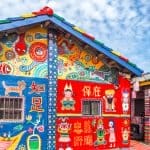
This is an awesome guide! Wish we would have had this before we visited Taroko Gorge last year. We’d love to go back and camp inside the park, and to do more hiking!
Wow! Grand Canyon indeed. What a magical place. I’d enjoy doing it by scooter. A simple rental than off I’d go, with wife in tow. Amazing experience because it mixes such lush greens with dramatic mountain and canyon scenery. Taiwan has much to offer. I feel the place is still well off the tourist beaten path in many regards. Rocking post dude!
Ryan
Your post makes me SUPER excited about my upcoming trip to Hualien! I’ll be there for five days and will be exploring the area. Never heard of Shakadang Trail before your blog post but it’s now on my to-do list!
Do you need a license to rent a scooter and are there a lot of bugs? I ask because I just came from NZ and they had crazy, crazy sandflies at gorges!
Great post avout Taroko Gorge! Just wondering if the places you’ve mentioned here are the exact order from the start of the Gorge until Tianxiang? If not can you give me a rundown of places to see starting from the start until the end? And if you rent bicycles, do they also give you a helmet and a lock for the bike? Hoping for your response!!!
Yes, the order of sights above is pretty much exactly as you would encounter them. Only Shakadang trail is off the main road. Right after the Taroko Gorge entrance gate, the main road continues on the same side up Taroko Gorge. But for Shakadang trail, you have to cross a bridge right after the entrance gate to the other side of the gorge, where you’ll find the visitor’s center, and a little further down, the Shakadang trail. Everything else after that is in order, on the main side of the road.
As for bicycles, I haven’t personally rented from those shops myself, so I can’t say for sure. I would hope they offer helmets. In Taiwan, it’s fairly common, outside of cities especially, for people to not bother using locks though. It’s really quite safe. Please let me know when you find out though, so I can know in the future!
Hello Nick,
Thanks for the awesome post about Taroko Gorge. I’m planning to visit Taiwan in August and would like to spend a weekend in Taroko Gorge. I’ve been researching on the NP and find your website super useful. I’d like to bring my camping gear from US to camp at the Heliu Campground. There’re 2 things I’m trying to figure out:
1/ As I read about the Heliu Campground, it is on 1st-come 1st-served basis. So what times would the campground be opened for walk-up and how would I pay the fees (in cash)?
2/ Is it safe to claim a campsite, set up my tent, and hop on the shuttle bus for day hikes in the Gorge, leaving my camping gears at the campsite to come back later at night? This is quite normal in the US but I’ve never had a chance to camp anywhere else so I’m a little bit worried about the safety.
Hoping for your response!!!
Hi Huy,
Sounds like you’ve got an awesome trip planned. I’ve only stayed at the campground once, but it was way back in 2008, so I can’t guarantee nothing has changed. When I stayed there, I remember we just walked in, chose a platform, and set up our tent. There was nobody even working there. I don’t even remember paying the fee, but maybe somebody came around later to collect it. For best luck to get a spot, you should try to come early, especially on weekends. Taiwan is extremely safe, and I think you can leave your things and not worry about them. Taiwan is the kind of place where people leave their laptops unattended for half an hour in a cafe. It’s probably smart to keep your most important valuables on you though, because you never know.
Hi, I am drawing an itinerary for Taiwan trip (Oct 14th morning – 19th afternoon) with my family – twin (26), my parents (55 & 65) who are not the most active adults. Thinking of sightseeing Taipei on 14,15 and spend 16 at Taroko Gorge.
Should I arrive from Taipei in the evening of 15th, stay overnight at Taroko and start early 17th oct at the national park and take train back or stay at Hualien. Take train back to taipei 18th morning/afternoon.
Or take a train in the morning 17th and leave bags at hotel, continue to Taroko during midday and rest overnight at Taroko. Take train back to taipei 18th morning/afternoon. (Is there much to see at Hualien or worth skipping?)
I wish to continue to Sunmoon lake next morning… but realise there are no trains connecting Hualien/Taroko to Sunmoon Lake. I realise driving from Taroko would take 5-6 hours and it would be too much for elderys their age.
Do you think it’s worth doing another one-day trip down there from Taipei-Taichung-(bust) Sun Moon Lake? If so how long would it take?
Please kindly advise. Many thanks
Hi Nick, do you know by chance if Island Life tours in Hualien/Taroko are still operating? I tried to contact them via multiple channels to arrange a private tour or two, but no luck. It’s weird that most recent reviews they have on FB and Google maps are from 2020 :-/
Hey Ivan, Island Life Tours, like most tour companies in Taiwan, relied on foreign tourists. Their business has been devastated by the lack of tourists coming to the island, so it’s not at all surprising that they aren’t running tours right now. We can only hope that they will manage to get their business back up and running again after Taiwan starts allowing tourists to come.
Hey Nick! Thank you for the comprehensive guide to a Taroko tour. I’m hoping to do it by bike and so far research hasn’t shown us a giant station next to xincheng. Have you had any experience with this?
Greetings from a Belgian traveller!
Hi Elise, sorry for my belated reply, I just saw this! At Xincheng Station you can rent bikes at “TR9-Xinchengzu Station” or “太魯閣車頭前機車腳踏車出租”, both right outside the station. I’m not sure whether the have Giant brand, but they definitely rent bikes. Best of luck!
Hi Elise,
Happy New Year 2023.
I plan to go to Taiwan this Feb. Did you have great time in Taiwan?
Stefan – also from Belgium
[email protected]
Hi Nick, where do you think is a good base to visit Taroko Gorge when travelling with a 3 year old and a 1 year old? My kids do not do great on long car rides. I am planning to drive through from Hualien to Cingjing, visiting Taroko Gorge in between. Obviously with kids, I am not going to be able to visit Taroko in single day. I do not mind too not visiting all of it. If you have any suggestions on how to make this visit to Taroko the most workable and ‘pain-free’ for parents with little kids, I’ll be most grateful. Thank you!
Hi Mel, and sorry about my slow reply. Please also see the Taroko Gorge section of my article “Taiwan with kids”, in which I describe our visit with kids and some kid-friendly hotels in the area. Hualien City has the best selection of rooms, but it also the furthest away. You said obviously you can’t visit taroko in a single day, but I feel you actually can. Simply driving through, you get to see a lot of the scenery. Stop at a few of the main stops, like Eternal Spring Shrine, Tunnel of Nine Turns, and Swallow’s Grotto, each which require a very short or almost no walk, and you’ve essentially seen the best of Taroko Gorge. As for your drive to Cingjing with kids, I would say that if you’re kids are prone to car sickness like mine, expect an extremely winding road. Let me know if you have any more questions!
Hi Nick
Thanks for all the info you provide on your various blogs ! it has been super helpful in planning our taiwan trip.
We need to travel from Sunmoon lake to taroko gorge- and we were considering renting a car and driving between the 2 locations and stopping at cinqing farm for 1 night. I am a bit concerned after reading your comment about the road being closed due to land slides?
What would your back up options be ? is this not recommended? we are planning to visit in Late sep- oct.
Thanks
Highway 8 above Taroko Gorge was badly damaged in three different spots several months ago in 2022. Right now the construction crews are still fixing the road, but they let cars pass through at some specific times every day. The exact times and locations are listed on the Taroko Gorge National Park website (click news, roads and trails, small arrow beside Highway 8 for updated details). It could be totally fixed before your trip, but also possible it’s not. It’s also possible that another typhoon could strike this year and cause more damage again (typhoon seasons is July to October). So this part is impossible to predict. So I suggest you plan to do it, but also have a backup plan in case it’s not possible. Maybe book a hotel in Cingjing that has a cancellation policy. And if you can’t go, you can just drive from SML to Taroko via Taipei, which will take longer, but still possible.
Hi Nick, thanks for all the recommendations and info provided! They are so useful! Can I check if any of the following trails at taroko is doable with a baby stroller? Do these trails have stairs such that bringing a stroller along will cause problems?
1)Baiyang Trail
2)Buluowan Suspension Bridge
3)Eternal Spring Shrine
4) Taroko Shakadang trail
Thank you!
All four of these are pretty flat and easy enough with kids. However, the ground is sometimes bumpy, and there could be a few stairs on all of them. So it’s better if you can bring a baby carrier, not stroller, like we did. If you have a small stroller that is easy to push over bumps or carry sometimes, then it would probably be OK.
Hi Nick, good day. grateful for your blog on Taroko gorge. I would like to enquire are there any options to go Taroko from Taichung using public transportation or tours? Instead of the usual route from Hualien to Taroko.
I understand the mountain route from Taroko to Hualien is commonly closed due to natural disasters.
I would be coming from the south and its quite troublesome to go to taipei and then go to hualien to taroko.
Thank you.
There is no faster or easier way to do this. The cross-island highway is damaged and repairs are not finished yet. Even when it’s open, there are no buses or tours going across the mountain range. The faster way from Taichung to Taroko is HSR to Taipei (1 hr) and express train to Hualien (2 hrs). Even if the road is safe to pass, it would take longer to drive across the mountains than going via Taipei.
Hi Nick! Do you know of any taxi services I can book that will take me from Hualien back to Taipei after my day tour?
You can use the Tripool app, contact Steven Hsieh (search “drivers” on my website’s search function to find my article with his contact info), or you can take the train, which is faster than driving.
Outstanding guide. What a legend. Thank you very much for the huge effort!
Good afternoon,
First and foremost, we wanted to express our gratitude for your detailed blog post about Taiwan. It has proven immensely helpful while planning our upcoming trip to Taiwan in November.
While your blog suggests touring Taroko Gorge either with a guided tour or a private vehicle, we’re more inclined towards using public transportation for our travels. We find comfort in buses and the freedom to explore at our own pace. Could you please advise if it’s possible to visit Taroko Gorge in a day using public transportation? If so, we would greatly appreciate guidance on where we can find information such as timetables, station details, and other relevant transport-related details.
Additionally, for context, we’ll be arriving in Hualien and plan to depart for Yuli on the same day after our visit to Taroko Gorge.
Thank you very much for your assistance. We’ll wait for your answer.
Have a nice day!
I almost always feel the same, but this is one case when I would personally go for the driver. The thing about bussing to Taroko is that it’s slower, and you’re coming to spend your whole day watching the bus schedule, trying to visit places fast or slow enough to catch the next bus, and waiting for the bus. There are at least half a dozen spots you’ll want to see in Taroko, so to heave to catch a bus to and between each of those will be tedious. By hiring a driver, you can create a customized tour, and not worry about how much or how little time you spend at each stop. If you decide to go by bus, it’s surely still doable, but I think you just have to accept that you’ll be able to see as many spots as if you have a driver. Having a driver also allows you to tack on Qingshui Cliffs, Qixingtan Beach, and if you want to swim in a lovely river, the Sanzhan swimming spot. By bus, you’ll probably have to leave these three spots out, too.
Hi Nick
Thank you for the great blog post!
My friend and I were planning on getting the train then bus to get to takoro gorge on a DIY day trip from Taipei. Once we get off the bus at the Takoro stop, is it going to be easy to see the main sights on foot or are there busses or taxis available to take us around?
Thank you!
Seeing the gorge by bus is not ideal. There are around half a dozen main stops/hikes in the gorge (and many smaller ones) spanning a distance of about 20 kilometers. So definitely you can’t walk to all of them, or even a few, and there will definitely be no taxis there. You will be at the mercy of the bus to get between stops. The bus is infrequent, so you’ll need to figure out the schedule, then try to always be at the bus stop for catching it to your next stop. It means you’ll probably only be able to see 2-3 stops in the gorge, and miss out on some of them. This is why I usually recommend splurging on a tour or private driver for Taroko Gorge, even though I normally always prefer to do things DIY or just drive there myself. Having a driver or joining a tour means you’ll be able to see all the main stops with ease.
Hi Nick,
Thank you so much for an incredible post. It is very helpful and detailed.
I’d like to ask if it’s safe to drive to taroko by ourselves from Hualien. We’re thinking of driving from Taipei to Hualien for the view and since the car will be there anyway I figured we could do a chill tour at Taroko by ourselves but I’ve heard from other travelers that it might not be the easiest road. Also we usually drive on the right side so if the road is too difficult that could be a problem?
Cheers,
Yw
I think under normal times the road in Taroko is fine. It’s a little narrow and winding in some places, but as long as you drive carefully, it’s OK. However, the biggest problem now is that the road in Taroko is damaged from landslides and under construction around Xipan Dam, in the middle of the tourist visiting part of the gorge. The road is only open 5 times per day for cars to pass. So you must know those times and plan accordingly. Please join my Facebook group “Taiwan Travel Planning” where we have many posts and updated information about this.
hmm, is there any food in taroko?
Yes, there are some snacks and lunchboxes for sale at Buluowan Terrace and an aboriginal restaurant in the hotel there. Option two is the 7-11 and some simple restaurants at Tianxiang.